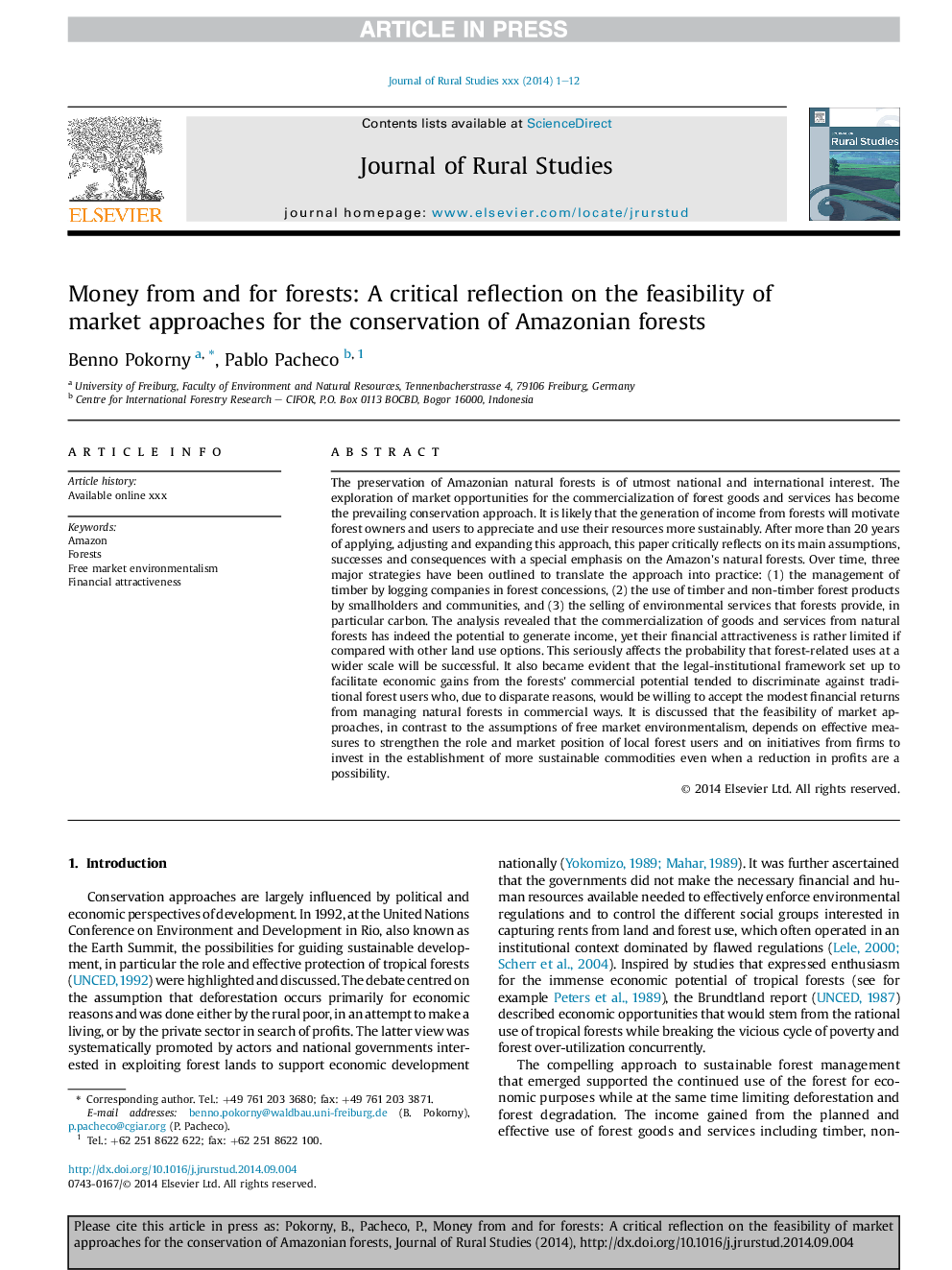| کد مقاله | کد نشریه | سال انتشار | مقاله انگلیسی | نسخه تمام متن |
|---|---|---|---|---|
| 6545789 | 159972 | 2014 | 12 صفحه PDF | دانلود رایگان |
عنوان انگلیسی مقاله ISI
Money from and for forests: A critical reflection on the feasibility of market approaches for the conservation of Amazonian forests
ترجمه فارسی عنوان
پول از و برای جنگل ها: بازتاب بحرانی در مورد امکان پذیری روش های بازار برای حفاظت از جنگل های آمازون
دانلود مقاله + سفارش ترجمه
دانلود مقاله ISI انگلیسی
رایگان برای ایرانیان
کلمات کلیدی
آمازون، جنگل ها، بازار آزاد محیط زیست، جذابیت مالی،
ترجمه چکیده
حفاظت از جنگل های طبیعی آمازون از اهمیت ملی و بین المللی برخوردار است. اکتشاف فرصت های بازار برای تجاری کالاها و خدمات جنگل تبدیل به رویکرد حفاظت غالب شده است. احتمال دارد که تولید درآمد حاصل از جنگل باعث شود صاحبان جنگل ها و کاربران به درک و استفاده از منابع خود پایدار تر باشند. پس از بیش از 20 سال از اعمال، تنظیم و گسترش این رویکرد، این مقاله به طور انتقادی بر پیش فرض های اصلی، موفقیت ها و پیامدهای آن تاکید ویژه ای بر جنگل های طبیعی آمازون دارد. با گذشت زمان، سه راهبرد عمده برای انتقال این رویکرد به عمل مشخص شده است: (1) مدیریت چوب با استفاده از شرکت های جنگلی در امتیازات جنگلی، (2) استفاده از محصولات جنگل و غیر جنگل توسط مالکین کوچک و جوامع و 3) فروش خدمات زیست محیطی که جنگل ها به ویژه کربن ارائه می دهند. تجزیه و تحلیل نشان داد که تجاری سازی کالاها و خدمات از جنگل های طبیعی در حقیقت پتانسیل تولید درآمد است، اما در مقایسه با سایر گزینه های استفاده از زمین، جذابیت مالی آنها کم است. این امر به طور جدی بر احتمال استفاده از جنگل ها در مقیاس وسیع تاکید می کند. همچنین مشخص شد که چارچوب قانونی-نهادی که برای تسهیل دستاوردهای اقتصادی از پتانسیل تجاری تجاری جنگل ها تسهیل می شود، تمایل به تبعیض علیه کاربران جنگل سنتی دارد که به دلایل متفاوتی مایل به پذیرش بازده مالی اندک از مدیریت جنگل های طبیعی در راه های تجاری. بحث شده است که امکان پذیری روش های بازار در مقایسه با فرضیه های محیط زیست بازار آزاد، به اقدامات موثر برای تقویت نقش و موقعیت بازار کاربران محلی جنگل و ابتکارات شرکت ها برای سرمایه گذاری در ایجاد کالاهای پایدارتر حتی بستگی دارد زمانی که کاهش سود ممکن است.
موضوعات مرتبط
علوم زیستی و بیوفناوری
علوم کشاورزی و بیولوژیک
جنگلداری
چکیده انگلیسی
The preservation of Amazonian natural forests is of utmost national and international interest. The exploration of market opportunities for the commercialization of forest goods and services has become the prevailing conservation approach. It is likely that the generation of income from forests will motivate forest owners and users to appreciate and use their resources more sustainably. After more than 20 years of applying, adjusting and expanding this approach, this paper critically reflects on its main assumptions, successes and consequences with a special emphasis on the Amazon's natural forests. Over time, three major strategies have been outlined to translate the approach into practice: (1) the management of timber by logging companies in forest concessions, (2) the use of timber and non-timber forest products by smallholders and communities, and (3) the selling of environmental services that forests provide, in particular carbon. The analysis revealed that the commercialization of goods and services from natural forests has indeed the potential to generate income, yet their financial attractiveness is rather limited if compared with other land use options. This seriously affects the probability that forest-related uses at a wider scale will be successful. It also became evident that the legal-institutional framework set up to facilitate economic gains from the forests' commercial potential tended to discriminate against traditional forest users who, due to disparate reasons, would be willing to accept the modest financial returns from managing natural forests in commercial ways. It is discussed that the feasibility of market approaches, in contrast to the assumptions of free market environmentalism, depends on effective measures to strengthen the role and market position of local forest users and on initiatives from firms to invest in the establishment of more sustainable commodities even when a reduction in profits are a possibility.
ناشر
Database: Elsevier - ScienceDirect (ساینس دایرکت)
Journal: Journal of Rural Studies - Volume 36, October 2014, Pages 441-452
Journal: Journal of Rural Studies - Volume 36, October 2014, Pages 441-452
نویسندگان
Benno Pokorny, Pablo Pacheco,
